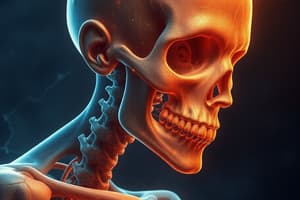Podcast
Questions and Answers
Which type of ossification is responsible for the formation of flat bones?
Which type of ossification is responsible for the formation of flat bones?
- Endochondral ossification
- Intramembranous ossification (correct)
- Articular ossification
- Most ossification
The articular cartilage ossifies at various ages throughout life.
The articular cartilage ossifies at various ages throughout life.
False (B)
What is the primary purpose of the epiphyseal plate?
What is the primary purpose of the epiphyseal plate?
Growth in the length of the bone
The hormone that reduces blood calcium levels and inhibits osteoclast activity is called _____ .
The hormone that reduces blood calcium levels and inhibits osteoclast activity is called _____ .
Match the following hormones with their effects on bone metabolism:
Match the following hormones with their effects on bone metabolism:
In which region does the epiphyseal plate disappear?
In which region does the epiphyseal plate disappear?
Vitamin D deficiency can lead to increased bone density.
Vitamin D deficiency can lead to increased bone density.
List the four stages of bone healing.
List the four stages of bone healing.
A deficiency in calcium and phosphate can lead to ____ in children.
A deficiency in calcium and phosphate can lead to ____ in children.
Which zone of the epiphyseal plate contains actively dividing cartilage cells?
Which zone of the epiphyseal plate contains actively dividing cartilage cells?
Flashcards
Intramembranous Ossification
Intramembranous Ossification
Bone formation that starts in a membrane of embryonic mesenchymal tissue and forms spongy bone.
Endochondral Ossification
Endochondral Ossification
Bone formation that replaces a cartilage template, creating long, short, and irregular bones.
Epiphyseal Plate
Epiphyseal Plate
Cartilage region in long bones responsible for lengthening the bone, disappearing in adulthood.
Calcitonin
Calcitonin
Signup and view all the flashcards
Parathyroid Hormone
Parathyroid Hormone
Signup and view all the flashcards
Bone Healing Stages
Bone Healing Stages
Signup and view all the flashcards
Rickets
Rickets
Signup and view all the flashcards
Osteomalacia
Osteomalacia
Signup and view all the flashcards
Growth Hormone
Growth Hormone
Signup and view all the flashcards
Vitamin D deficiency
Vitamin D deficiency
Signup and view all the flashcards
Study Notes
Bone Ossification and Repair
- Bone formation (ossification) occurs in two ways:
- Intramembranous ossification: Occurs in flat bones, starting in a membrane of embryonic mesenchymal tissue and ending with spongy bone formation.
- Endochondral ossification: Occurs in long, short, and irregular bones. It involves the replacement of a pre-existing hyaline cartilage model, resembling the future bone's shape.
Epiphyseal Plate Zones
- The epiphyseal plate is divided into five zones:
- Resting cartilage zone: Cartilage cells are inactive.
- Proliferative cartilage zone: Cartilage cells actively divide.
- Hypertrophic cartilage zone: Cartilage cells enlarge.
- Calcified cartilage zone: Cartilage matrix hardens.
- Ossification zone: Cartilage is replaced by bone.
Epiphyseal Plate Function
- The epiphyseal plate is responsible for bone lengthening.
- It disappears in adulthood (around 20 years of age), ceasing bone lengthening.
- Articular cartilage, unlike the epiphyseal plate, never ossifies, remaining as hyaline cartilage throughout life.
Factors Affecting Bone Growth
-
Hormonal factors:
- Calcitonin: Produced by thyroid gland, reduces blood calcium levels by inhibiting osteoclasts.
- Parathyroid hormone: Promotes osteoclastic activity, increasing blood calcium levels.
- Growth hormone: Deficiency during growth leads to pituitary dwarfism. Excess can cause gigantism or acromegaly.
- Thyroid hormone: Deficiency in children causes cretinism and dwarfism.
-
Nutritional factors:
- Calcium and phosphate: Deficiency leads to incomplete bone matrix calcification (rickets in children and osteomalacia in adults).
- Vitamin D: Deficiency causes rickets in children.
- Vitamin C: Deficiency causes scurvy, resulting in brittle bones.
Bone Fracture Healing
- Hematoma formation: Initial stage, involving blood clot formation.
- Fibrocartilaginous callus formation: Cartilage and fibrous tissue replace the hematoma.
- Bony callus formation: Spongy bone forms the callus.
- Bone remodeling: Bone is reshaped to its original form and strength.
Studying That Suits You
Use AI to generate personalized quizzes and flashcards to suit your learning preferences.




